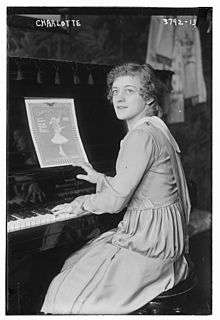Charlotte Oelschlägel
| Charlotte Oelschlagel | |
|---|---|
 Charlotte Oelschlagel in 1916 | |
| Personal information | |
| Full name | Charlotte Oelschlagel |
| Alternative names | Charlotte Hayward |
| Country represented |
|
| Born |
August 14, 1898 Berlin |
| Died |
November 14, 1984 (aged 86) Berlin |
Charlotte Oelschlägel, aka Charlotte Hayward (August 14, 1898 in Berlin - November 14, 1984 in Berlin) was a German professional skater. For most of her life, she used only her first name as her stage name. She invented and first performed the figure skating elements death spiral and charlotte spiral, which is named after her.
Personal life
Charlotte Oelschlägel was born in Berlin. As well as being a figure skater, she was also a musician. At age seven, she was on stage with the Berlin Philharmonic. She played the mandolin, lute, harp and piano. When she was 10 years old, she suffered from nervous and growing problems. Medications did not help. She was advised to do figure skating to treat her medical problems.
She was married to Curt Neumann, also a figure skater. She died in a retirement home in Berlin on November 14, 1984.
Career
She initially skated with her brother Fritz. Later, she was coached by Paul Münder.
In 1915, she became the first performer to star in a Broadway ice show, appearing in Hip-Hip-Hooray! at the New York Hippodrome. She was also the first skater to star in a motion picture, the American drama film The Frozen Warning (1917).[1]
With Neumann, she performed the first one arm death spiral in Budapest in 1928.
In 1929, she appeared for last time in a United States show in Cincinnati, Ohio. In 1939, her professional figure skating career ended due to the beginning of World War II. Her passport was confiscated by the Nazis. After the war, she worked as a coach at the club Grunewalder TC. She retired in 1976. She was inducted into the World Figure Skating Hall of Fame in 1985.[2]
References
- Pirouette, 1995, numbers 5 and 6
External links
| Wikimedia Commons has media related to Charlotte Oelschlägel. |